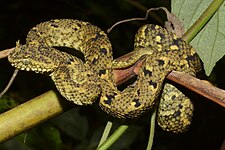Atheris ceratophora: Difference between revisions
imported>Jaap Winius (Removed red links and other minor edits. Replaced ITIS links.) |
Pat Palmer (talk | contribs) mNo edit summary |
||
| (5 intermediate revisions by 3 users not shown) | |||
| Line 1: | Line 1: | ||
{{subpages}} | |||
{{Image|Atheris ceratophora 188224791.jpg|right|225px|Usambara Eyelash Viper (''Atheris ceratophora'')}}. | |||
{{Taxobox | {{Taxobox | ||
| color = pink | | color = pink | ||
| Line 18: | Line 20: | ||
* ''Atheris ceratophora'' - Broadley, 1996<ref name="McD99">McDiarmid RW, Campbell JA, Touré T. 1999. Snake Species of the World: A Taxonomic and Geographic Reference, vol. 1. Herpetologists' League. 511 pp. ISBN 1-893777-00-6 (series). ISBN 1-893777-01-4 (volume).</ref> | * ''Atheris ceratophora'' - Broadley, 1996<ref name="McD99">McDiarmid RW, Campbell JA, Touré T. 1999. Snake Species of the World: A Taxonomic and Geographic Reference, vol. 1. Herpetologists' League. 511 pp. ISBN 1-893777-00-6 (series). ISBN 1-893777-01-4 (volume).</ref> | ||
}} | }} | ||
'''''Atheris ceratophora''''' is a venomous [[Viperinae|viper]] species found only in a few mountain ranges in Tanzania. This is the only horned, arboreal viper in Africa.<ref name="SB95"/> No subspecies are currently recognized.<ref name="ITIS">[http://www.itis.gov/servlet/SingleRpt/SingleRpt?search_topic=TSN&search_value=634942 ''Atheris ceratophora'' (TSN 634942)] at [http://www.itis.gov/index.html Integrated Taxonomic Information System]. Accessed 24 March 2007.</ref> | |||
'''Common names''': Usambara bush viper,<ref name="SB95">Spawls S, Branch B. 1995. The Dangerous Snakes of Africa. Ralph Curtis Books. Dubai: Oriental Press. 192 pp. ISBN 0-88359-029-8.</ref> horned bush viper, eyelash bush viper,<ref name="WOA">[http://www.kingsnake.com/atheris/ceratophora.html ''Atheris ceratophora''] at [http://www.kingsnake.com/atheris/index.html The World Of Atheris]. Accessed 25 March, 2007.</ref> [[#Common names|more]]. | '''Common names''': Usambara bush viper,<ref name="SB95">Spawls S, Branch B. 1995. The Dangerous Snakes of Africa. Ralph Curtis Books. Dubai: Oriental Press. 192 pp. ISBN 0-88359-029-8.</ref> horned bush viper, eyelash bush viper,<ref name="WOA">[http://www.kingsnake.com/atheris/ceratophora.html ''Atheris ceratophora''] at [http://www.kingsnake.com/atheris/index.html The World Of Atheris]. Accessed 25 March, 2007.</ref> [[#Common names|more]]. | ||
{{TOC|left}} | |||
==Description== | ==Description== | ||
Grown to a maximum length of 54 cm. Females slightly larger than males. The maximum length for a male is reported to be 42 cm, the tail of which measured 8 cm.<ref name="Mal03">Mallow D, Ludwig D, Nilson G. 2003. True Vipers: Natural History and Toxinology of Old World Vipers. Krieger Publishing Company, Malabar, Florida. ISBN 0-89464-877-2.</ref> | Grown to a maximum length of 54 cm. Females slightly larger than males. The maximum length for a male is reported to be 42 cm, the tail of which measured 8 cm.<ref name="Mal03">Mallow D, Ludwig D, Nilson G. 2003. True Vipers: Natural History and Toxinology of Old World Vipers. Krieger Publishing Company, Malabar, Florida. ISBN 0-89464-877-2.</ref> | ||
| Line 45: | Line 45: | ||
Most likely nocturnal or crepuscular.<ref name="Mal03"/> | Most likely nocturnal or crepuscular.<ref name="Mal03"/> | ||
== | ==Attribution== | ||
{{WPAttribution}} | |||
==Cited references== | ==Cited references== | ||
< | <small> | ||
<references | <references> | ||
</references> | |||
</small> | |||
Latest revision as of 08:38, 6 October 2024
.
| Atheris ceratophora | ||||||||||||||||||||
|---|---|---|---|---|---|---|---|---|---|---|---|---|---|---|---|---|---|---|---|---|
| Scientific classification | ||||||||||||||||||||
| ||||||||||||||||||||
| Binomial name | ||||||||||||||||||||
| Atheris ceratophora Werner, 1895 | ||||||||||||||||||||
| Synonyms | ||||||||||||||||||||
|
Atheris ceratophora is a venomous viper species found only in a few mountain ranges in Tanzania. This is the only horned, arboreal viper in Africa.[2] No subspecies are currently recognized.[3]
Common names: Usambara bush viper,[2] horned bush viper, eyelash bush viper,[4] more.
Description
Grown to a maximum length of 54 cm. Females slightly larger than males. The maximum length for a male is reported to be 42 cm, the tail of which measured 8 cm.[5]
Easily recognized by a set of 3-5 horn-like superciliary scales above each eye. The rostral scale has more than twice the length of its width. It has 9 upper labials. The chin shield contacts 3 of the lower labials.[5]
Mid-body, the dorsal scales number 21-25. The ventral scale count is 142-152. There are 41-56 subcaudals.[5]
The color pattern consists of a yellowish-green, olive, gray or black ground color. This may or may not be overlaid by variable markings, sometimes in the form of irregular black spots or cross-bars that may be lined with yellow or white spots. The belly is dirty orange to almost black in color, sometimes with dark spots.[2]
Common names
Usambara bush viper,[2] horned bush viper, eyelash bush viper,[4] Usambara mountain bush viper.[5]
Geographic range
The Usambara and Uzungwe Mountains in Tanzania. The type locality is "Usambara" Mountains [Tanzania].[1] They are probably also found in the Uluguru Mountains.[2]
Habitat
Found in grass and low bushes about 1 m above the ground[2] in woodlands and forests at altitudes of 700 to over 2000 m.[5]
Behavior
Most likely nocturnal or crepuscular.[5]
Attribution
- Some content on this page may previously have appeared on Wikipedia.
Cited references
- ↑ 1.0 1.1 McDiarmid RW, Campbell JA, Touré T. 1999. Snake Species of the World: A Taxonomic and Geographic Reference, vol. 1. Herpetologists' League. 511 pp. ISBN 1-893777-00-6 (series). ISBN 1-893777-01-4 (volume).
- ↑ 2.0 2.1 2.2 2.3 2.4 2.5 Spawls S, Branch B. 1995. The Dangerous Snakes of Africa. Ralph Curtis Books. Dubai: Oriental Press. 192 pp. ISBN 0-88359-029-8.
- ↑ Atheris ceratophora (TSN 634942) at Integrated Taxonomic Information System. Accessed 24 March 2007.
- ↑ 4.0 4.1 Atheris ceratophora at The World Of Atheris. Accessed 25 March, 2007.
- ↑ 5.0 5.1 5.2 5.3 5.4 5.5 Mallow D, Ludwig D, Nilson G. 2003. True Vipers: Natural History and Toxinology of Old World Vipers. Krieger Publishing Company, Malabar, Florida. ISBN 0-89464-877-2.
